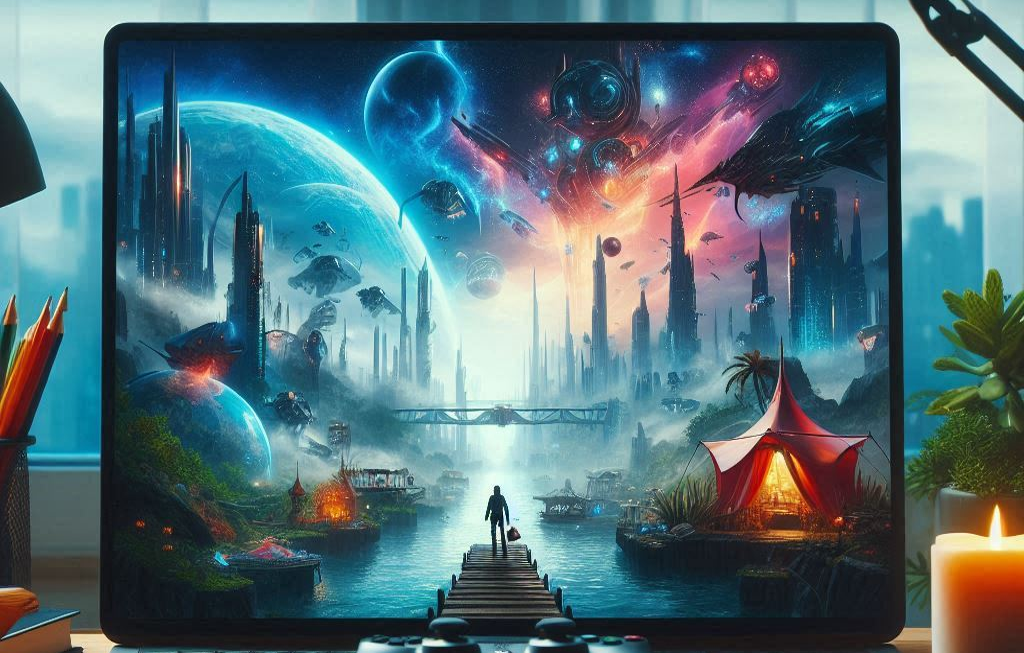Sound and music have always been a big part of video games, even in the early ones. In the beginning, games used simple sounds to warn players, create moods, or just make the game more fun. Sounds like the “beep” when you score points or the “boing” when you jump were very important. They helped players understand what was happening in the game.
Music also played a key role. It could make a scary game feel even scarier or a fun game feel more cheerful. Players often remember the music from games like “Super Mario” or “Tetris” because it was catchy and made the games more exciting. The notes and tunes helped shape the feelings we have about the games we played.
In summary, sound and music were not just extras in early video games; they were essential for making the games enjoyable. They helped create a connection between the player and the game, making everything more exciting and memorable.
Glossary:
Sound: The noise that comes from the game, like beeps or crashes.
Music: The tunes played in the game that set the mood.
Player: The person who plays the game.
Exciting: Something that makes you feel happy and energetic.
The role of sound and music in early video games is an important topic that highlights how audio elements shaped the gaming experience. Although early video games had limited technology, the sounds they produced had a significant impact on players’ emotions and engagement. This text will explore the various aspects of sound and music in early video games, the challenges developers faced, and the innovative solutions they devised.
The Importance of Sound in Gaming
Sound in video games serves multiple functions. It provides feedback to players, enhances storytelling, and creates atmosphere. Here are some key roles of sound in gaming:
- Feedback: Sounds indicate actions, such as winning a level or losing a life.
- Atmosphere: Background music sets the mood of the game world.
- Storytelling: Audio can convey emotions and help in narrating the game’s story.
Early Video Game Sound
In the early days of video gaming, technology imposed limits on what could be done with sound. Games often relied on simple beeps and boops generated by sound chips. Despite these limitations, developers found creative ways to engage players. Here are some notable examples:
- Pong (1972): The simple sound effects enhanced gameplay by providing feedback with every paddle hit.
- Space Invaders (1978): The increasing tempo of the music as aliens descended added tension to the game.
- Pac-Man (1980): Its memorable sound effects and music made it an iconic game even today.
Challenges in Early Sound Design
Creating sound for early video games came with several challenges:
- Technological Limitations: Sound chips could only produce a few tones and lacked the capability for complex music.
- Memory Constraints: Video game cartridges had limited storage space, leaving little room for audio files.
- Budget Restrictions: Developing rich soundscapes often required resources that were unavailable in the early years.
Innovative Solutions
Despite the challenges, game developers found innovative solutions to create engaging audio experiences:
- Chiptune Music: Composers created music using the sound chips available, resulting in unique, catchy tunes that became part of gaming culture.
- Sound Effects Libraries: Developers used libraries of sound effects to quickly add various sounds to their games.
- Looping and Sampling: Techniques allowed for longer, more complex audio pieces without requiring excessive memory, which enhanced gameplay.
“It’s fascinating to see how these early sound choices set the stage for what we now consider audio in video games.”
The Lasting Impact of Early Game Sound
The sounds from early video games have had a long-lasting impact on the industry. Many of these sounds and music tracks have become iconic and are still referenced today. Here’s how they influenced modern gaming:
- Cultural Influence: Many games pay homage to classic sounds, and remixing chiptunes has become a popular genre.
- Game Design: Sound design has become a crucial part of game development, with dedicated sound designers playing important roles in projects.
- Player Engagement: Well-crafted audio continues to enhance game immersion, showing that sound remains a key aspect of the gaming experience.
In summary, the role of sound and music in early video games was crucial to shaping player experiences, creating engaging gameplay, and setting the foundation for the future of audio in games. Through creative solutions, developers overcame technological limitations, ultimately paving the way for the rich audio landscapes we enjoy in video games today.
“As we remember the early days of video games, the unique sounds remind us how far we’ve come in audio technology.”
Understanding the origins of game sound helps appreciate the advancements made over the years. The blend of creativity and technology has allowed video games to become a rich medium of entertainment and storytelling.
What was the significance of sound in early video games?
Sound played a crucial role in early video games by enhancing the overall player experience. It provided feedback on player actions, created atmosphere, and added emotional depth to the game. This was particularly important in an era when graphics were limited and sound could help to engage players more effectively.
What types of sounds were commonly used in early video games?
Early video games commonly used simple sound effects like beeps, boops, and short melodies. These sounds were typically synthesized using basic waveforms, allowing developers to convey actions such as jumping, shooting, or collecting items. Music was often looped, with catchy tunes designed to keep players entertained during gameplay.
How did sound design evolve in early video games?
Over time, sound design in video games evolved significantly. Initially limited by hardware capabilities, developers began to experiment with various sound synthesis techniques, leading to more complex audio experiences. By the late 1980s and early 1990s, the introduction of advanced sound chips and hardware synthesis allowed for richer soundtracks and more diverse sound effects.
What impact did music have on the gaming experience?
Music added a deeper layer of immersion, helping to establish the game’s mood and pace. Iconic soundtracks became synonymous with certain games, enhancing brand recognition and player nostalgia. Music also served to signal in-game events, indicating changes in gameplay or alerting players to important moments.
Did sound and music influence the design of gameplay?
Yes, sound and music often heavily influenced gameplay design. Developers used audio cues to guide players, providing hints about what actions to take or alerting them to potential dangers. This interplay between sound and gameplay mechanics helped create a more cohesive and engaging experience.
What are some examples of early games known for their soundtracks?
Some notable early games with memorable soundtracks include “Super Mario Bros.,” which featured catchy tunes that became iconic, and “The Legend of Zelda,” which had a rich musical score that complemented its adventurous gameplay. These soundtracks have left a lasting legacy in gaming culture.
How do modern games build on the foundations of early sound design?
Modern games build on early sound design by incorporating advanced audio techniques, such as 3D spatial audio and interactive soundscapes. While early games focused on simple sound effects, today’s games use audio to create immersive worlds, enhance narrative storytelling, and provide dynamic responses to player actions.



